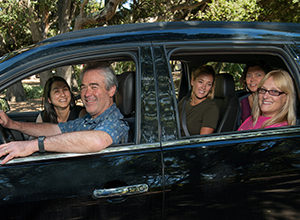Stanford’s Transportation Demand Management (TDM) program grew out of a need to meet peak-trip reduction goals established in its General Use Permit (GUP) and reduce university-related traffic impact. Stanford’s GUP is issued by the County of Santa Clara and governs campus growth and development. Today, Stanford’s TDM program is one of the most comprehensive in the country.
Even with significant campus growth, the TDM program has resulted in measurable reductions in commuter emissions and a significant increase in the use of alternative transportation. It plays an essential role in the university’s sustainability effort. Stanford has been transitioning to more sustainable campus shuttles and fleet vehicles, adding electric vehicle (EV) charging stations, increasing shuttle route efficiency, and expanding its other sustainable transportation efforts.
The Stanford Commute Club is a key element of the TDM program. The Commute Club rewards each member with up to $300 a year, among other incentives, for commuting primarily by sustainable transportation. In 2015-16, Commute Club membership increased by 155 members over 2014-15 levels. Stanford has also continued to expand other transportation programs, including car sharing, and now hosts one of the largest university Zipcar programs in the nation.

Stanford is a Platinum-level Bicycle Friendly University
Stanford has expanded its bicycle program to accommodate an estimated 13,000 bikes on campus each day. The expansion has included adding bicycle safety repair stands, which now total eight, and increasing bicycle parking capacity. In 2015-16, Stanford added one new bike locker compound on campus, providing 20 new bike lockers. This brings the total for secure bike parking spaces to 460 (351 in bike lockers and 109 in bike cages). In addition, Stanford provides more than 19,000 bike rack parking spaces on campus, with 1,000 added in the last year. These efforts and more have earned Stanford recognition as a Platinum-level Bicycle Friendly University. The Platinum designation is the highest award issued by the League of American Bicyclists to colleges and universities. In 2015, Stanford became the sole university to receive a renewal of its designation, which now extends to 2019.
These TDM advances, coupled with extensive marketing outreach and promotions, have enabled Stanford to reduce its drive-alone rate by 22 percentage points since 2002, with half of university employee commuters now primarily using sustainable transportation.
Results
In 2015, the employee drive-alone rate totaled 50%, compared to 72% in 2002 at the inception of the enhanced TDM program.
Additional achievements for 2015-16 include the following:
- Passenger numbers for Marguerite—Stanford’s free public shuttle service that travels around campus and connects to nearby transit, shopping, dining, and entertainment—rose from 2.5 million in 2014 to an estimated 3.1 million in 2015.
- Stanford’s Bike to Work Day had a record-breaking year in 2016. With more than 2,500 Stanford bicycle commuters and 135 pedestrians participating, Stanford saw a 17% increase over 2015.

10 EV charging stations were added in 2015
- Stanford more than doubled the number of EV charging stations on campus, adding 10 charging stations in high-demand parking areas. Stanford now has a total of 24 EV charging stations, including off-campus sites. All stations are Level 2 (240V charging via SAE J1772 connector).
- Stanford hosted its second annual Corporate Bike Forum at the Stanford Research Park, drawing more than 30 leading Silicon Valley businesses to share best practices and challenges with their bicycle programs. Attendees also experienced an on-site demo of e-bike technology and a bike tour of the main campus.
- About 40% of Stanford’s 1,084 fleet vehicles are electric, with an ever-increasing number of hybrid options. The operations bike fleet includes six electric bikes and 27 pedal-powered bikes, most of which are equipped with GPS. Collectively the bike fleet has been ridden more than 200 miles, saving emissions equivalent to those generated by burning 50 pounds of coal.
- The Marguerite shuttle fleet includes 23 electric buses, 5 diesel-electric hybrid buses, and 58 vans, shuttles, and buses.
Looking Ahead
Many new and exciting initiatives are in development, including plans to address Stanford’s long-term growth both on and off campus. TDM remains a priority sustainability program at Stanford, with implications beyond the university’s main campus. With current commute trends in Silicon Valley pointing to an increase in traffic congestion, Stanford launched a regional transportation planning initiative under the leadership of Land, Buildings & Real Estate that is slated for completion in the third quarter of 2016.

Vanpooling will be free for riders beginning September 2016
Stanford will make vanpooling free to riders starting in September 2016. For new and existing vanpoolers, the university will pay the costs of a base van with at least five riders. This new approach is hoped to accelerate the adoption of vanpooling among Stanford commuters.
The construction of a new underground parking structure will allow for the addition of 50 more EV charging stations in 2016 to encourage alternatives to gas-powered vehicles. New technology will also be evaluated during the coming year to help manage TDM programs and improve sustainable commute options, including dynamic ride matching and improved trip planning.
